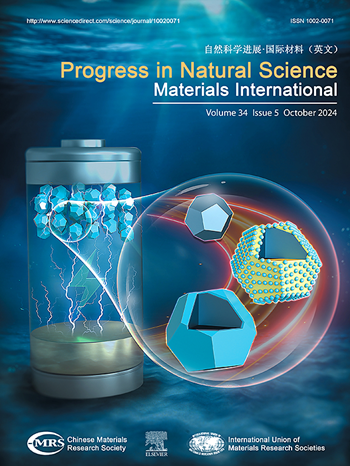High-throughput screening of efficient Metal-Organic Frameworks for the generation of reactive oxygen species
IF 7.1
2区 材料科学
Q2 MATERIALS SCIENCE, MULTIDISCIPLINARY
Progress in Natural Science: Materials International
Pub Date : 2025-08-01
DOI:10.1016/j.pnsc.2025.05.002
引用次数: 0
Abstract
Metal-organic frameworks (MOFs) are recognized as promising catalysts for generating reactive oxygen species (ROS) due to their exceptional properties. However, identifying the most efficient MOF candidates remains challenging. In this study, the ROS generation performance of MOFs was predicted using Density Functional Theory (DFT) and a multi-step high-throughput screening process. This screening involved evaluations of structural stability, pore size, adsorption capacity, open metal sites, O2 activation potential, and free energy simulations of reaction pathways. As a result, several MOFs (i.e., Cu-tris(4-aminophenyl)amine (Cu-MOF), Zn-2-H-MeIM (Zn-MOF), and Ce-2-amino-1,4-benzenedicarboxylic) (Ce-MOF) were identified as potential catalysts for ROS generation under both light and dark conditions. Especially, Cu-MOF was identified as the most efficient catalyst, generating 7.52 mmol g−1 H2O2 in 1 h under light irradiation, and 2.88 mmol g−1 H2O2 in the dark. Furthermore, the polarity of coordination bonds between the metal atoms and ligand atoms in the ligands was found to significantly influence O2 activation. The ROS generation trend of MOFs was consistent with the polarity of these coordination bonds. The sterilization efficiency of Cu-MOF and Zn-MOF reached 99.9 % after 40 min of light exposure, while after 100 min in the dark, the efficiencies were 99.9 % and 41.6 %, respectively. This trend was closely related to the variation in the polarity of coordination bonds. This work provides a strategy and methodology for high-throughput screening of MOFs.
用于生成活性氧的高效金属有机骨架的高通量筛选
金属有机骨架(MOFs)由于其独特的性能被认为是一种很有前途的活性氧(ROS)催化剂。然而,确定最有效的MOF候选者仍然具有挑战性。在本研究中,利用密度泛函理论(DFT)和多步高通量筛选过程预测了mof的ROS生成性能。筛选包括结构稳定性、孔径、吸附能力、开放金属位点、O2活化电位和反应途径的自由能模拟。因此,几种mof(即cu -三(4-氨基苯基)胺(Cu-MOF), Zn-2-H-MeIM (Zn-MOF)和ce -2-氨基-1,4-苯二羧酸)(Ce-MOF)在光照和黑暗条件下都被确定为ROS生成的潜在催化剂。其中Cu-MOF的催化效率最高,光照条件下1 h可生成7.52 mmol g−1 H2O2,光照条件下1 h可生成2.88 mmol g−1 H2O2。此外,还发现配体中金属原子与配体原子之间的配位键的极性显著影响O2的活化。mof的ROS生成趋势与这些配位键的极性一致。光照40 min后Cu-MOF和Zn-MOF的杀菌效率达到99.9%,光照100 min后Cu-MOF和Zn-MOF的杀菌效率分别为99.9%和41.6%。这一趋势与配位键极性的变化密切相关。本研究为mof的高通量筛选提供了一种策略和方法。
本文章由计算机程序翻译,如有差异,请以英文原文为准。
求助全文
约1分钟内获得全文
求助全文
来源期刊
CiteScore
8.60
自引率
2.10%
发文量
2812
审稿时长
49 days
期刊介绍:
Progress in Natural Science: Materials International provides scientists and engineers throughout the world with a central vehicle for the exchange and dissemination of basic theoretical studies and applied research of advanced materials. The emphasis is placed on original research, both analytical and experimental, which is of permanent interest to engineers and scientists, covering all aspects of new materials and technologies, such as, energy and environmental materials; advanced structural materials; advanced transportation materials, functional and electronic materials; nano-scale and amorphous materials; health and biological materials; materials modeling and simulation; materials characterization; and so on. The latest research achievements and innovative papers in basic theoretical studies and applied research of material science will be carefully selected and promptly reported. Thus, the aim of this Journal is to serve the global materials science and technology community with the latest research findings.
As a service to readers, an international bibliography of recent publications in advanced materials is published bimonthly.

 求助内容:
求助内容: 应助结果提醒方式:
应助结果提醒方式:


